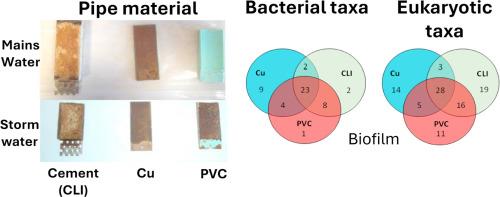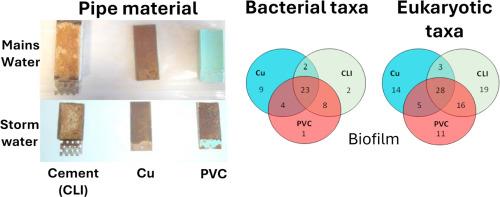暴雨对输水管网中生物膜密度和微生物群落组成的影响
IF 12.4
1区 环境科学与生态学
Q1 ENGINEERING, ENVIRONMENTAL
引用次数: 0
摘要
收集雨水并将其注入含水层,以便在高需水量时期进行储存和回收,是一项很有前景的增加常规水储备的技术。然而,人们对雨水如何影响输水基础设施的生物污垢知之甚少。本研究评估了经雨水收集和石灰岩含水层处理的雨水与相同的饮用水管道设备相比,对试点输水管网中生物膜形成的影响。水泥管、铜管和聚氯乙烯(PVC)管材料制成的试样被安装到每个管道装置上,并暴露在雨水或饮用水中。通过流式细胞仪测定的试验平台试样上的总细胞数在两种源水中都在 105 到 107 个细胞/平方厘米之间,并且在研究期间有一些变化。暴露在雨水中的试样的可培养细胞数略高于主水中的试样。暴露在雨水中的试样的耐热大肠菌群总数明显高于暴露在自来水中的试样。利用热释光测序法观察到,暴露在自来水和暴雨中的各种材料制成的试样上的细菌和真核生物群落存在很大差异。此外,还观察到群落组成和多样性的季节性变化。在自来水和雨水系统中都检测到了一些携带潜在人类病原体的细菌和真核生物科和属,其中雨水系统中观察到的属数量更多,这表明接触雨水中病原体的风险可能会增加。雨水系统中还含有硫还原剂和更多的铁氧化剂。在自来水和雨水系统中都观察到了一些有助于氮循环的细菌属。还发现了一些放牧真核生物的细菌,这表明生物膜群落相当活跃,丰富的细菌能够支持更高级别的真核生物。本文章由计算机程序翻译,如有差异,请以英文原文为准。


Impact of stormwater on biofilm density and microbial community composition in water distribution networks
Harvesting of stormwater and injecting it into aquifers for storage and recovery during high water demand periods is a promising technology for augmenting conventional water reserves. However, little has been known on how stormwater impacts the biofouling of water distribution infrastructure. This study evaluated the effect on harvested and limestone aquifer treated stormwater on biofilm formation in a pilot distribution pipe network compared to an identical drinking water pipe rig. Coupons made of cement, copper and polyvinyl chloride (PVC) pipe materials were installed to each pipe rig and exposed to stormwater or drinking water. The total cell counts determined by flow cytometry on the pilot rig coupons were in the order of 105 to 107 cells/cm2 for both source waters and showed some variation over the duration of the study. The culturable cell counts were somewhat higher for stormwater exposed coupons than for coupons in mains water rig. The total number of thermotolerant coliforms was notably higher on coupons exposed to stormwater than on those exposed to mains water. Considerable differences were observed in the bacterial and eukaryotic communities on coupons made of various materials and exposed to mains water and stormwater using pyrosequencing. Moreover, seasonal variations were observed in community composition and diversity. A number of bacterial and eukaryotic families and genera harbouring potential human pathogens were detected in both mains water and stormwater systems, with larger numbers of genera observed in the latter indicating a potentially increased risk of exposure to pathogens with stormwater. The stormwater system also harboured sulfur reducers, and a greater diversity of iron oxidisers. A number of bacterial genera that contribute to nitrogen cycling were observed in both mains water and stormwater systems. A number of bacteria grazing eukaryotes were detected, indicating that the biofilm communities are quite dynamic and the abundance of bacteria is able to support higher level eukaryotes.
求助全文
通过发布文献求助,成功后即可免费获取论文全文。
去求助
来源期刊

Water Research
环境科学-工程:环境
CiteScore
20.80
自引率
9.40%
发文量
1307
审稿时长
38 days
期刊介绍:
Water Research, along with its open access companion journal Water Research X, serves as a platform for publishing original research papers covering various aspects of the science and technology related to the anthropogenic water cycle, water quality, and its management worldwide. The audience targeted by the journal comprises biologists, chemical engineers, chemists, civil engineers, environmental engineers, limnologists, and microbiologists. The scope of the journal include:
•Treatment processes for water and wastewaters (municipal, agricultural, industrial, and on-site treatment), including resource recovery and residuals management;
•Urban hydrology including sewer systems, stormwater management, and green infrastructure;
•Drinking water treatment and distribution;
•Potable and non-potable water reuse;
•Sanitation, public health, and risk assessment;
•Anaerobic digestion, solid and hazardous waste management, including source characterization and the effects and control of leachates and gaseous emissions;
•Contaminants (chemical, microbial, anthropogenic particles such as nanoparticles or microplastics) and related water quality sensing, monitoring, fate, and assessment;
•Anthropogenic impacts on inland, tidal, coastal and urban waters, focusing on surface and ground waters, and point and non-point sources of pollution;
•Environmental restoration, linked to surface water, groundwater and groundwater remediation;
•Analysis of the interfaces between sediments and water, and between water and atmosphere, focusing specifically on anthropogenic impacts;
•Mathematical modelling, systems analysis, machine learning, and beneficial use of big data related to the anthropogenic water cycle;
•Socio-economic, policy, and regulations studies.
 求助内容:
求助内容: 应助结果提醒方式:
应助结果提醒方式:


